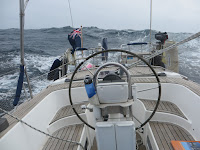We weren't sure about the welcome here, it was only 400 years ago that a fleet of 130 ships left A Coruna with the Spanish Armada and got soundly whooped by Francis Drake (once he'd finished his game of bowls at Plymouth Hoe), Drake then popped down to A Coruna the following year and gave the town a good spanking for its cheek!

All was well however although they still required insurance documents, ships papers, passports and a form completed saying where you came from, where you were going, the height of the mast, what the boat was made of.......only stopping short of the colour of the skippers underpants! These they duly copied and filed, never to be seen again. Oh well, jobs for the boys I suppose.
The Tower of Hercules was fascinating. The tower, built by the Romans as a lighthouse lit using olive oil stood tall for 1500 years , quite a monument to Roman building but by the 17th century it was falling into serious disrepair. Even in those days they treasured their antiquities and not wanting to loose the tower altogether they built a 'modern' stone skin around the outside and extended the height by 5 meters for a new light. When you go inside you can see the whole of the inside of the original Roman structure; very impressive.

On one evening that we were anchored in the harbour the big boys were out racing. This fellow must have had his wife on board who wanted to take the opportunity to dry the bed sheets! (An expensive days sailing!)
 From A Coruna it was south west and the winds are firmly behind us, quite a treat after 5 years of beating into the prevailing winds. The north west coast is know as the 'Costa del Muerte' - the coast of death - hmm! There are two versions of the name; the first is from the ancients who believed that the west coast was the end of the world and offshore was where the dead folk lived so the coast was the meeting of the dead and the living or, more recently, the coast of death was the home to thousand of ship wrecks on this unforgiving Atlantic coast. Either way - take care! It is rugged indeed but the scenery is beautiful.
From A Coruna it was south west and the winds are firmly behind us, quite a treat after 5 years of beating into the prevailing winds. The north west coast is know as the 'Costa del Muerte' - the coast of death - hmm! There are two versions of the name; the first is from the ancients who believed that the west coast was the end of the world and offshore was where the dead folk lived so the coast was the meeting of the dead and the living or, more recently, the coast of death was the home to thousand of ship wrecks on this unforgiving Atlantic coast. Either way - take care! It is rugged indeed but the scenery is beautiful. Round the great Cape Finistere, famed as the most westerly point of Europe, (actually it isn't but it nearly is and makes a good stop for the tourist coaches!) we stopped in at Corcubion, the home of lace making in Galicia. Before the industrial revolution caught up with the cottage industries of Galicia hundreds of women could be found gathered together making all manner of beautiful lace items. With a pattern fixed to a cushion, many lengths of cotton each length wound a spool would be interwoven and run around pins stuck into the pattern. The clacking of the spools as the women fingers flew across the pattern must have made quite a symphony!
Round the great Cape Finistere, famed as the most westerly point of Europe, (actually it isn't but it nearly is and makes a good stop for the tourist coaches!) we stopped in at Corcubion, the home of lace making in Galicia. Before the industrial revolution caught up with the cottage industries of Galicia hundreds of women could be found gathered together making all manner of beautiful lace items. With a pattern fixed to a cushion, many lengths of cotton each length wound a spool would be interwoven and run around pins stuck into the pattern. The clacking of the spools as the women fingers flew across the pattern must have made quite a symphony!We were told by some folk we met in A Coruna that rounding the great cape the temperature would take a significant step for the better. An old wives tale? No, it really did! With jumpers on in the breeze on the north side we were down to tee shirts on the south side with exactly the same wind - extraordinary but rather nice! The sun was out with a vengence for the next few days and we discovered what Melanie had come for, golden beaches and azur blue waters, even warm enough for Melanie to swim!


















